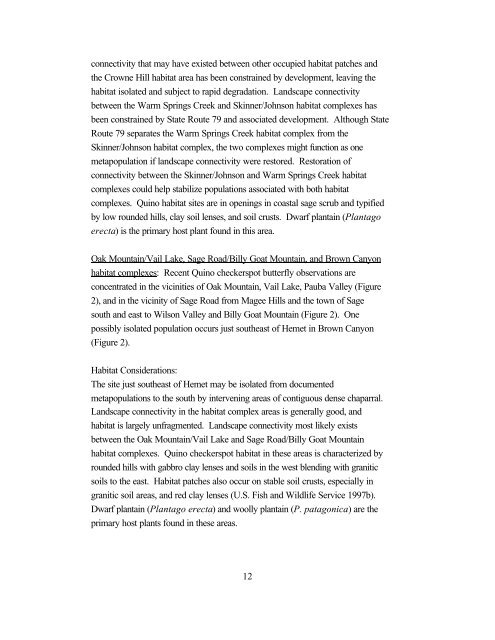Outline of Quino Recovery Plan - The Xerces Society
Outline of Quino Recovery Plan - The Xerces Society
Outline of Quino Recovery Plan - The Xerces Society
Create successful ePaper yourself
Turn your PDF publications into a flip-book with our unique Google optimized e-Paper software.
connectivity that may have existed between other occupied habitat patches and<br />
the Crowne Hill habitat area has been constrained by development, leaving the<br />
habitat isolated and subject to rapid degradation. Landscape connectivity<br />
between the Warm Springs Creek and Skinner/Johnson habitat complexes has<br />
been constrained by State Route 79 and associated development. Although State<br />
Route 79 separates the Warm Springs Creek habitat complex from the<br />
Skinner/Johnson habitat complex, the two complexes might function as one<br />
metapopulation if landscape connectivity were restored. Restoration <strong>of</strong><br />
connectivity between the Skinner/Johnson and Warm Springs Creek habitat<br />
complexes could help stabilize populations associated with both habitat<br />
complexes. <strong>Quino</strong> habitat sites are in openings in coastal sage scrub and typified<br />
by low rounded hills, clay soil lenses, and soil crusts. Dwarf plantain (<strong>Plan</strong>tago<br />
erecta) is the primary host plant found in this area.<br />
Oak Mountain/Vail Lake, Sage Road/Billy Goat Mountain, and Brown Canyon<br />
habitat complexes: Recent <strong>Quino</strong> checkerspot butterfly observations are<br />
concentrated in the vicinities <strong>of</strong> Oak Mountain, Vail Lake, Pauba Valley (Figure<br />
2), and in the vicinity <strong>of</strong> Sage Road from Magee Hills and the town <strong>of</strong> Sage<br />
south and east to Wilson Valley and Billy Goat Mountain (Figure 2). One<br />
possibly isolated population occurs just southeast <strong>of</strong> Hemet in Brown Canyon<br />
(Figure 2).<br />
Habitat Considerations:<br />
<strong>The</strong> site just southeast <strong>of</strong> Hemet may be isolated from documented<br />
metapopulations to the south by intervening areas <strong>of</strong> contiguous dense chaparral.<br />
Landscape connectivity in the habitat complex areas is generally good, and<br />
habitat is largely unfragmented. Landscape connectivity most likely exists<br />
between the Oak Mountain/Vail Lake and Sage Road/Billy Goat Mountain<br />
habitat complexes. <strong>Quino</strong> checkerspot habitat in these areas is characterized by<br />
rounded hills with gabbro clay lenses and soils in the west blending with granitic<br />
soils to the east. Habitat patches also occur on stable soil crusts, especially in<br />
granitic soil areas, and red clay lenses (U.S. Fish and Wildlife Service 1997b).<br />
Dwarf plantain (<strong>Plan</strong>tago erecta) and woolly plantain (P. patagonica) are the<br />
primary host plants found in these areas.<br />
12
















